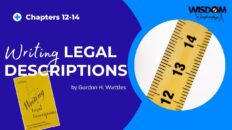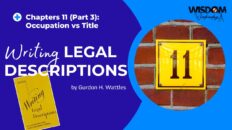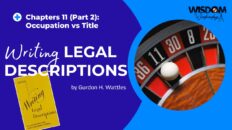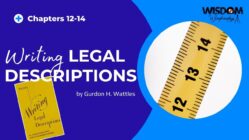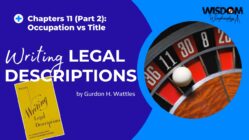Wisdom Wednesdays for the land surveying profession is a bi-weekly roundtable discussion to go over a chapter at a time from our “Surveying Bibles.” The goal is for everyone to read a chapter of a book and then have a roundtable discussion about that chapter. The current book being discussed is Writing Legal Descriptions by Gurdon H. Wattles.
Meeting Summary: AI-Generated:
| Sufficiency of Land Deeds Discussed | |
| Trent Williams led a discussion on the importance of determining the sufficiency of a deed or land description. He highlighted the challenges young surveyors often encounter in identifying when a deed is sufficient or insufficient. Trent emphasized the necessity of considering various forms of evidence, such as field surveys and adjacent deeds, and the importance of recognizing when a deed might appear insufficient but is actually sufficient after all factors are considered. Jeremiah added that some counties rewrite descriptions for tax purposes, which can lead to deficiencies, and emphasized the need to check these descriptions for bounding calls. James noted that while tax descriptions are sometimes used in Arkansas, they often contain inaccuracies or deficiencies. James discussed the importance of precise land descriptions, stating that they must accurately delineate a particular piece of property. The conversation was also briefly interrupted by Jerry, who clarified his stance on a previous topic of discussion. Jerry discussed the process of writing descriptions for property surveys and highlighted that once the description leaves their hands, it can be modified or stripped by other professionals, like attorneys or title people. The discussion ended with a note from Trent Keenan expressing appreciation for Trent Williams analogy about not knowing who’s sweeping away their footsteps. | |
| Boundary Description Dispute and Licensing Requirements | |
| Jeremiah discussed a dispute with a title company regarding the sufficiency of a boundary description. The team discussed the challenges of rewriting the description and the legal implications of any deviations from a surveyor’s description. Jerry highlighted the varying licensing requirements across jurisdictions, with Trent Keenan adding that recorders now need to sign and seal every legal description. Trent Williams then asked attendees from other states about their requirements for recording a deed. Connie shared her experience in California, where only land surveyors can write legal descriptions. | |
| Property Legal Description Clarity | |
| Connie and Trent Williams stressed the importance of clear and accurate legal descriptions in property ownership. They suggested that property owners should be able to locate their properties on the ground using the legal descriptions. James shared his experience of sometimes resolving conflicts in legal descriptions and other times involving an attorney for a quiet title operation. The team also discussed a map shared by Joe, which raised questions about its authenticity and whether it was a legal document or a company property inventory map. The team agreed to be cautious about the language and unclear elements in the descriptions and to ensure consistency. | |
| Land Deed Ambiguity Discussion | |
| James and Trent Williams discussed the ambiguity of a land deed, particularly in relation to its description and the location of a point of beginning. James argued that the deed, while not entirely clear in its instructions, provides sufficient information to recreate the property layout on the ground, and that the point of beginning would be perpendicular to the lot line across. He expressed confidence that all surveyors would reach the same conclusion. Trent Williams, however, pointed out that the starting point was not explicitly defined, leading to potential confusion. | |
| Legal Description Clarity: Importance and Challenges | |
| The team discussed the importance of attention to detail in legal descriptions. They highlighted the potential for ambiguity at the beginning of a description, which could lead to errors further into the text. Trent Williams and James emphasized the need for professionals to be able to interpret and correct unclear descriptions. They also pointed out the potential for disagreements among surveyors on the exact interpretation of a legal description. The team agreed that the brevity, simplicity, and completeness of a description could impact its understanding and potential for errors. | |
| Payment, Surveys, Quality Feedback, Book Review, Property Parcels, Adjoiner, Intentions, Thorough Research | |
| Trent Williams led a discussion about the payment of writers and the reviewing of surveys in the engineering world. The conversation revealed that some professionals get paid per comment, which can affect the quality of feedback. The team then shifted focus to their book review, emphasizing the importance of clear intentions when calling for joiners. Trent Keenan suggested using simple directions such as right of ways. The team also discussed the importance of recording information when dealing with property parcels and referred to the original document when dealing with adjacent properties. Jerry and Jeremiah highlighted the importance of thorough research and that calling to an adjoiner could add valuable information. The practice of calling to a grantor’s line was also discussed, with Trent explaining that he only does this when dealing with easements. | |
| Land Surveying: Importance, Complexities, and Errors | |
| Jeremiah shared a story about the importance of thorough surveying to avoid errors in land descriptions. brian, a surveyor for the Department of Energy, Environmental Protection, and the Connecticut State Surveyor, discussed his role in managing 265,000 acres of property. Trent Williams then emphasized the complexities of land surveying, including the use of artificial and natural monuments, the role of maps, plats, and field notes, and the potential for conflicts. He also stressed the importance of direction and distance in describing boundaries, and the need to approach discrepancies holistically. Trent highlighted the role of ties in land surveying and the potential for errors due to typographical errors, misreadings, or mathematical mistakes. | |
| Proportional Measurements and Property Surveying Challenges | |
| Trent Williams led a discussion on proportional measurements, simultaneous conveyance, remnant theory, and apportionment theory, with Trent Keenan and others agreeing to hold off on some topics for further discussion. There was also a discussion about the number of surveys per state, with Trent Keenan sharing his research. James emphasized the importance of thorough research in surveying projects, narrating an incident where an engineering company he worked with had to buy a multimillion dollar piece of property that was owned by the State of Arkansas. brian and James shared insights on the challenges of property surveying in their respective states, Connecticut and Arkansas. The team agreed to meet again on the 27th. | |
| AI-generated content may be inaccurate or misleading. Always check for accuracy. | |



